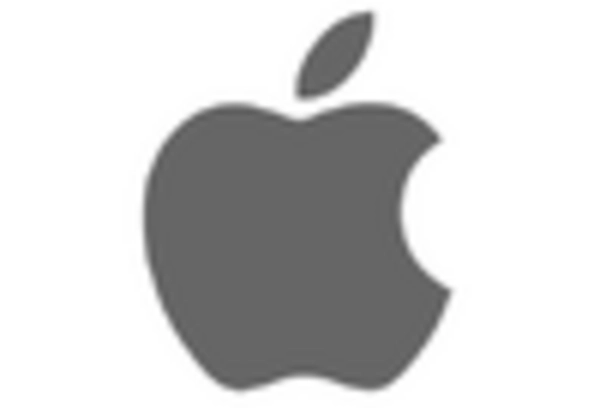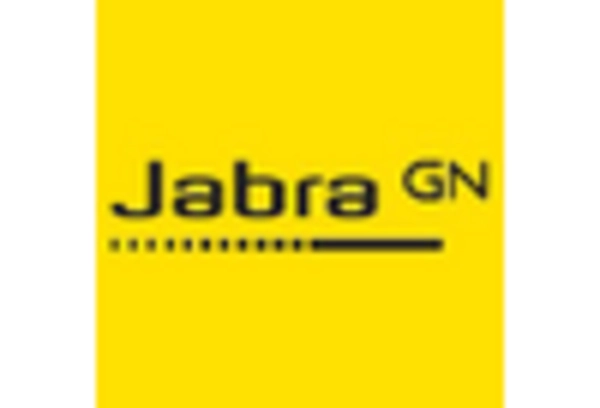Growth of the Fitness and Wellness Sector
The fitness and wellness sector significantly influences the smart headphones market, as consumers increasingly seek products that enhance their exercise routines. In 2025, it is estimated that around 40% of smart headphone users in the US utilize their devices during workouts, highlighting the demand for features such as sweat resistance and fitness tracking capabilities. This trend aligns with the broader movement towards health-conscious lifestyles, where technology plays a pivotal role in monitoring physical activity. Manufacturers are responding by developing smart headphones that integrate fitness tracking features, such as heart rate monitoring and activity logging. This convergence of fitness and audio technology is likely to foster innovation within the smart headphones market, appealing to a health-oriented consumer base.
Rising Demand for Wireless Audio Solutions
The smart headphones market experiences a notable surge in demand for wireless audio solutions, driven by the increasing preference for convenience and mobility among consumers. As of 2025, approximately 70% of headphone users in the US favor wireless options, reflecting a significant shift in consumer behavior. This trend is further supported by advancements in Bluetooth technology, which enhance connectivity and audio quality. The proliferation of mobile devices, such as smartphones and tablets, has also contributed to this demand, as users seek seamless integration with their gadgets. Consequently, manufacturers are focusing on developing innovative wireless smart headphones that cater to this growing consumer base, thereby propelling the smart headphones market forward. The emphasis on portability and ease of use is likely to continue shaping product offerings in the industry.
Technological Advancements in Audio Quality
Technological advancements play a crucial role in shaping the smart headphones market, particularly in enhancing audio quality. Innovations such as active noise cancellation (ANC) and high-resolution audio capabilities are becoming increasingly prevalent. As of 2025, nearly 60% of consumers in the US prioritize sound quality when selecting headphones, indicating a strong market inclination towards superior audio experiences. These advancements not only improve user satisfaction but also create opportunities for brands to differentiate themselves in a competitive landscape. Furthermore, the integration of artificial intelligence (AI) in sound processing is emerging as a game-changer, allowing for personalized audio experiences. This focus on audio fidelity is likely to drive growth in the smart headphones market, as consumers become more discerning in their audio preferences.
Increased Focus on Personalization and Customization
The smart headphones market is witnessing an increased focus on personalization and customization, as consumers seek products that reflect their individual preferences. In 2025, surveys indicate that approximately 55% of US consumers are interested in customizable audio settings, allowing them to tailor their listening experiences. This trend is indicative of a broader shift towards personalized technology, where users desire control over their devices. Manufacturers are responding by incorporating features that enable users to adjust sound profiles, noise cancellation levels, and even design elements. This emphasis on personalization not only enhances user satisfaction but also fosters brand loyalty, as consumers are more likely to engage with products that cater to their unique needs. The smart headphones market is likely to continue evolving in this direction, as personalization becomes a key differentiator among competing brands.
Expansion of Streaming Services and Content Consumption
The expansion of streaming services has a profound impact on the smart headphones market, as consumers increasingly engage with audio content on various platforms. As of 2025, over 50% of US consumers subscribe to at least one streaming service, leading to a heightened demand for high-quality audio devices. This trend is further amplified by the rise of podcasts and audiobooks, which have become popular forms of entertainment. Consequently, smart headphones that offer superior sound quality and comfort are becoming essential for an immersive listening experience. Brands are likely to capitalize on this trend by enhancing their product offerings to cater to the needs of content consumers, thereby driving growth in the smart headphones market. The interplay between content consumption and audio technology is expected to shape future developments in the industry.
















Leave a Comment